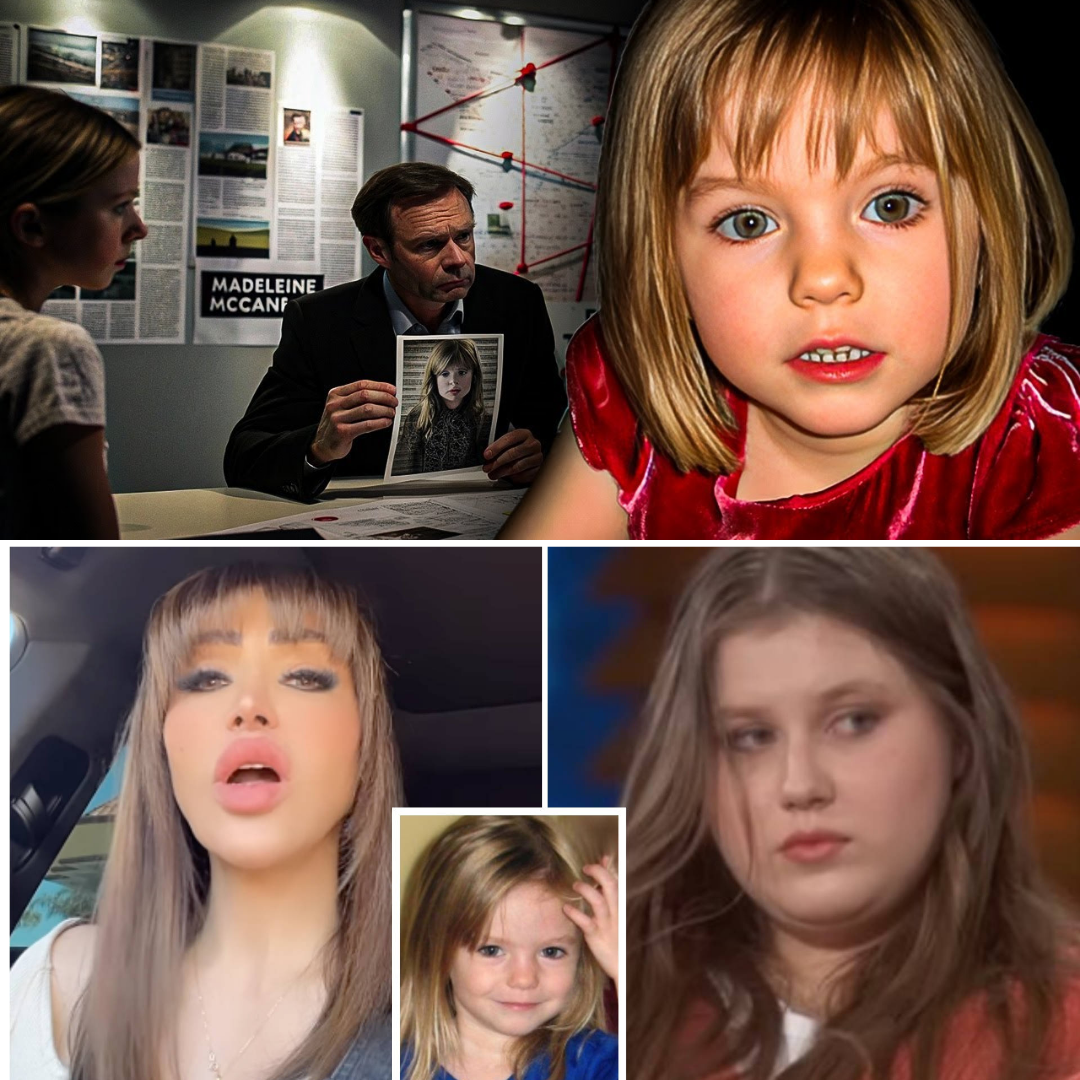New Evidence in the Julia Wendell and Madeleine McCann Case: Could She Be the Missing Girl?
The disappearance of Madeleine McCann on May 3, 2007, from a holiday apartment in Praia da Luz, Portugal, remains one of the most haunting mysteries in modern history. The three-year-old’s vanishing sparked a global search, yet nearly 18 years later, no definitive answers have emerged. In 2023, Julia Wendell, a 23-year-old Polish woman, ignited a media firestorm by claiming she is Madeleine McCann, citing physical similarities and fragmented childhood memories. Initially dismissed after DNA tests showed she was predominantly Polish, Wendell’s claims resurfaced in February 2025 with what she calls “explosive new evidence.” Her assertion that “This changes everything” has reignited debate, with alleged DNA, dental, and voice analyses suggesting a link to Madeleine’s father, Gerry McCann. This article explores the new evidence, its implications, and the broader context of the case, drawing on objective insights from web searches to assess whether Wendell could indeed be Madeleine.

The Emergence of Julia Wendell’s Claims
Julia Wendell, also known as Julia Wandelt or Faustyna, first gained attention in February 2023 when she launched the Instagram account @IamMadeleineMcCann. She posted side-by-side photos comparing her features to Madeleine’s, highlighting a shared coloboma of the iris—a rare eye defect affecting 1 in 10,000 people—along with similar moles, freckles, and facial structure. Wendell claimed she had no clear memories of her childhood before age eight, with her earliest recollection being of “white buildings” and a beach, reminiscent of Praia da Luz. She also alleged she was sexually abused by a man resembling a suspect sketch from the McCann case, fueling her belief she was abducted.
Wendell’s initial claims were met with skepticism. In April 2023, a DNA test, facilitated by private investigator Dr. Fia Johansson, confirmed she was nearly 100% Polish, with traces of Lithuanian and Romanian heritage, ruling out a British connection. Her Polish family, devastated by her assertions, provided photos and hospital records proving she was their daughter, born in Wroclaw. Wendell issued a 17-page apology to Kate and Gerry McCann, admitting regret for the distress caused and clarifying she never explicitly claimed to be Madeleine but sought answers about her identity. She told BBC Radio 4’s Why Do You Hate Me? podcast that her belief stemmed from childhood abuse and similarities between her abuser and a McCann case suspect, possibly Martin Ney, a convicted German pedophile once linked to the investigation.
Despite retreating from the spotlight, Wendell reemerged in November 2024 on a new Instagram account, @amijuliawandelt, promising “new evidence.” By February 2025, she released what she described as groundbreaking findings, reigniting global interest and prompting accusations of stalking the McCann family, leading to her arrest in Bristol on February 19, 2025.
The New Evidence: What’s Been Revealed?
In a series of Instagram posts in February 2025, Wendell presented what she claims is compelling evidence, analyzed by an undisclosed “world expert.” The key points are:
DNA Analysis: Wendell alleges her DNA was compared to hair and saliva found at the Praia da Luz crime scene. She claims the results show a 69.23% match, with genetic markers suggesting she is “part British, part Irish,” contradicting the 2023 test that identified her as fully Polish. The analysis, per Wendell, “strongly supports that Gerry McCann could be Julia Wandelt’s biological father,” citing a parent-child relationship based on shared markers. Her spokesperson, Surjit Singh Clair, told the Daily Mail that the McCanns and Wendell’s Polish parents refused DNA tests, and police declined to organize one, despite the alleged crime scene link.
Dental and Facial Comparisons: The expert reportedly analyzed photos of Wendell’s teeth and facial features, concluding that “shape, alignment, spacing, gum line, cheek lifting, and gum shape” match Madeleine’s, indicating they “undeniably belong to the same person.” Wendell shared images highlighting these similarities, though no independent verification has been provided.
Voice Analysis: A voice comparison, allegedly using “pitch, loudness, and spectral centroid,” suggested Wendell’s voice matches Madeleine’s, despite the challenge of comparing a child’s voice to an adult’s. Discrepancies were attributed to recording conditions, but the methodology remains unclear.
Physical Similarities: Wendell reiterated her coloboma, moles on her cheek and leg, and facial structure as evidence. She claims these traits, combined with the new analyses, outweigh the 2023 DNA results, which she suggests may have been tampered with or misinterpreted.
These claims, detailed in outlets like Marca and The Tab, have sparked intense debate. Wendell’s refusal to name the expert or publish full results has drawn criticism, with Instagram followers questioning why the findings aren’t “breaking news” if conclusive. The closure of Effective Media, the company linked to Clair, in 2015 adds to the skepticism, as does the McCanns’ silence and refusal to engage with DNA testing.
The Context of the McCann Case
To evaluate Wendell’s claims, it’s essential to revisit the McCann investigation. Madeleine vanished from her family’s apartment at the Ocean Club while Kate and Gerry McCann dined 50 meters away with friends, the “Tapas Seven.” The group checked on their children periodically, but at 10:00 PM, Kate discovered Madeleine missing, with the apartment’s window and shutter open. The Portuguese police’s initial response was criticized for failing to secure the crime scene, delaying border alerts, and neglecting CCTV and phone data. Early sightings, like Jane Tanner’s report of a man carrying a child at 9:15 PM and the Smith family’s similar account at 10:00 PM, were under-pursued.
By September 2007, the McCanns were named suspects based on inconclusive DNA in a rental car and sniffer dog alerts, but they were cleared in 2008. The investigation shifted in 2020 when German authorities named Christian Brueckner, a convicted rapist and burglar living in the Algarve from 1995 to 2007, as the prime suspect. Evidence, including a 2013 confession that Madeleine “didn’t scream,” suggests he abducted and killed her, though no charges have been filed due to insufficient evidence. Searches, like those at the Arade Dam in 2023 and 2025, have yielded no breakthroughs.
The McCanns, now in their late 50s, continue their search, marking Madeleine’s 22nd birthday in 2025 with a statement: “Still missing … still very much missed.” The case’s global attention has invited numerous false claims, with Wendell’s being the most prominent since a 2011 sighting in India.
Analyzing the New Evidence
Wendell’s evidence, while intriguing, faces significant hurdles:
DNA Credibility: The 2023 DNA test, conducted by a reputable lab, confirmed Wendell’s Polish heritage with no British ancestry, aligning with her family’s records. The new claim of a 69.23% match with crime scene DNA lacks transparency, as the expert’s identity and methodology are undisclosed. Forensic experts note that crime scene DNA, often degraded, requires rigorous chain-of-custody protocols, which Wendell’s team has not verified. The assertion that Gerry McCann could be her father is biologically implausible without direct parental DNA comparison, and the McCanns’ refusal to test suggests skepticism or a desire to avoid further distress.
Dental and Facial Analysis: Photo-based comparisons of teeth and facial features are subjective without standardized metrics. Madeleine’s childhood photos, taken at age three, are difficult to compare to an adult’s, and no forensic odontologist has corroborated the findings. The claim that features “undeniably” match ignores natural changes over time.
Voice Analysis: Comparing a toddler’s voice to an adult’s is scientifically dubious, as vocal cords change significantly with age. The cited metrics—pitch and spectral centroid—require controlled conditions and baseline data, which are absent for Madeleine. This analysis appears speculative at best.
Physical Similarities: The coloboma, while rare, affects 800,000 people globally, and Wendell’s eye defect appears less pronounced than Madeleine’s, possibly corrected by lenses or surgery. Moles and freckles can develop with age, weakening their reliability as identifiers. Facial recognition firm Ava-X’s 2023 analysis found a 90% likelihood that Wendell is not Madeleine, further undermining these claims.
Wendell’s history of claiming to be other missing girls, like Inga Gehricke and Acacia Bishop, and her mental health struggles, including self-harm and therapy, suggest a psychological basis for her fixation. Her family’s statement that she “refuses treatment” and seeks attention aligns with Dr. Johansson’s 2023 observation that Wendell struggled to accept the Polish DNA results, fearing her mother wasn’t biological.
The Broader Implications
Wendell’s claims, whether genuine or misguided, highlight the challenges of high-profile missing persons cases. The McCann investigation, costing £12.9 million by 2022, has been hampered by early errors and media frenzy. False claims, like Wendell’s, divert resources and cause emotional harm, as seen in her alleged stalking of the McCanns, including unsolicited visits and messages in 2024 and 2025. Her Bristol arrest on February 19, 2025, for stalking Kate, Gerry, and their twins, Sean and Amelie, underscores the toll on the family, who have maintained silence to focus on credible leads.
The media’s amplification of Wendell’s story, from her Dr. Phil appearance to 2025 headlines in Marca and JOE.co.uk, reflects a double-edged sword. While it keeps Madeleine’s case alive, it fuels misinformation, as seen in X posts speculating about her identity without evidence. The public’s fascination, evident in Wendell’s million-plus Instagram followers, risks overshadowing legitimate efforts, like the focus on Brueckner.
Could Wendell Be Madeleine?
The new evidence, while provocative, lacks the rigor to overturn the 2023 DNA results or the McCanns’ documented timeline. Madeleine would be 22 in 2025, roughly matching Wendell’s age, but discrepancies—such as Wendell’s fuller lips, drooping eyes, and Polish hospital records—undermine her claims. Her trafficking theory, supported by Johansson, conflicts with her family’s evidence and the absence of adoption records. The alleged crime scene DNA match, if true, would require extraordinary circumstances, such as contamination or fraud, to explain her Polish heritage.
Wendell’s narrative may stem from trauma, as she told the BBC her abuser’s resemblance to a suspect triggered her belief. Her lack of childhood memories and distrust of her family, possibly exacerbated by mental health issues, could drive her fixation. The McCanns’ refusal to engage, combined with police dismissal of her claims, suggests authorities prioritize Brueckner’s investigation over unverified assertions.
The Path Forward
For Wendell’s evidence to gain traction, it must be independently verified. Publishing the full DNA report, identifying the expert, and subjecting the findings to peer review are essential. A court-ordered DNA test, though legally challenging in Poland, could resolve the parentage claim, but the McCanns’ reluctance reflects their focus on closure through established channels. Portuguese and British police, who treat the case as a missing persons inquiry despite German assumptions of Madeleine’s death, could re-examine crime scene DNA with modern techniques, but Wendell’s claims alone are unlikely to prompt this.
The McCanns’ enduring hope, expressed in their 2025 birthday message, contrasts with the pain of false leads. Wendell’s case, while drawing attention, risks further anguish, as seen in her family’s plea for her to seek help. The investigation’s best chance lies in pursuing Brueckner, whose Algarve presence and criminal history remain the strongest lead.
Conclusion
Julia Wendell’s claim to be Madeleine McCann, bolstered by alleged DNA, dental, and voice evidence, has captivated the world, with her assertion that “This changes everything” reigniting a nearly 18-year-old mystery. Yet, the lack of transparency, questionable methodologies, and her history of similar claims cast doubt on her assertions. The 2023 DNA test, her Polish family’s evidence, and the McCanns’ silence outweigh the new findings, which require rigorous validation to be credible. While Wendell’s story highlights the emotional complexity of missing persons cases, it also underscores the need for verified evidence to avoid compounding a family’s grief. As the search for Madeleine continues, the truth remains elusive, but hope persists that answers will one day emerge—whether through Brueckner’s prosecution or an unexpected breakthrough.





